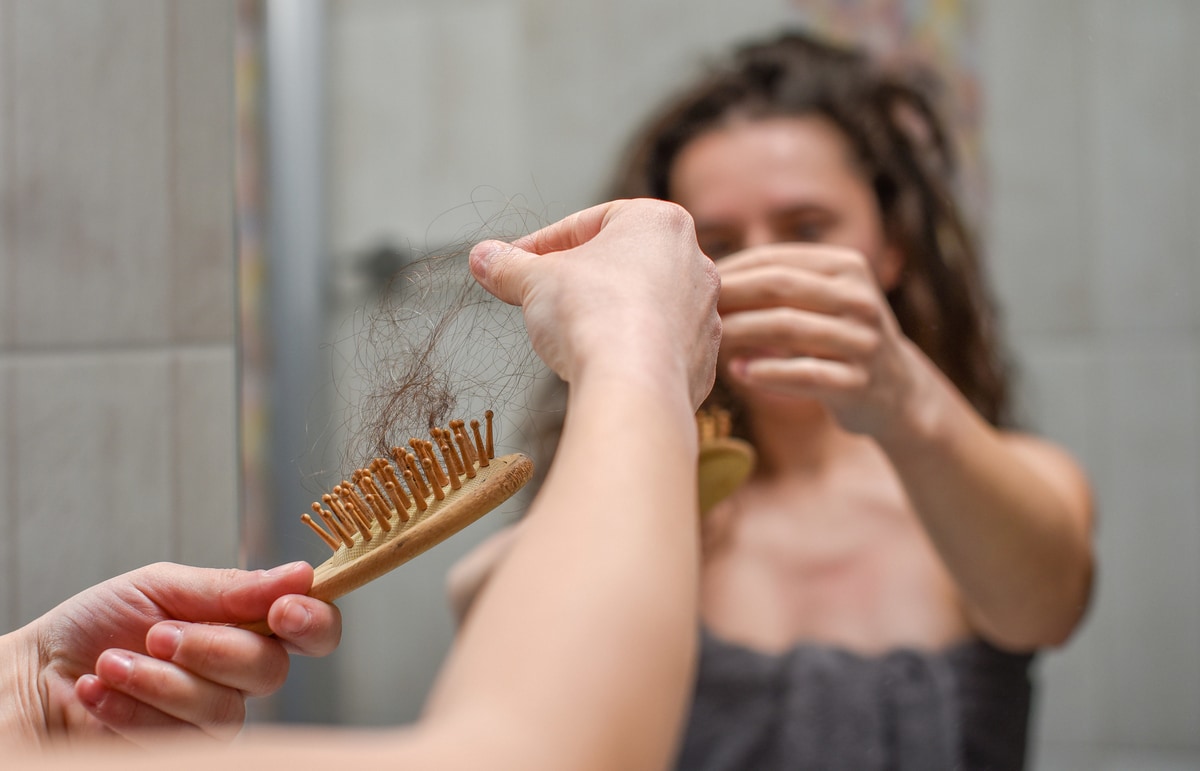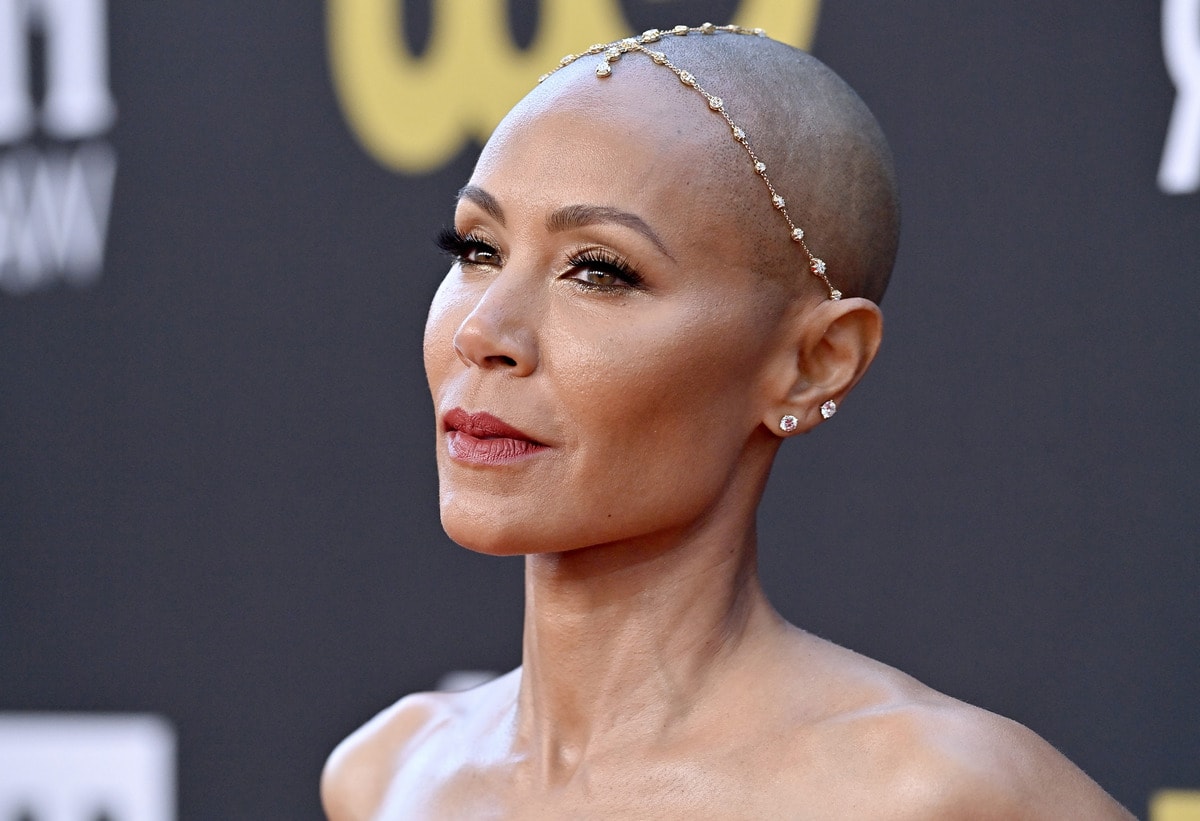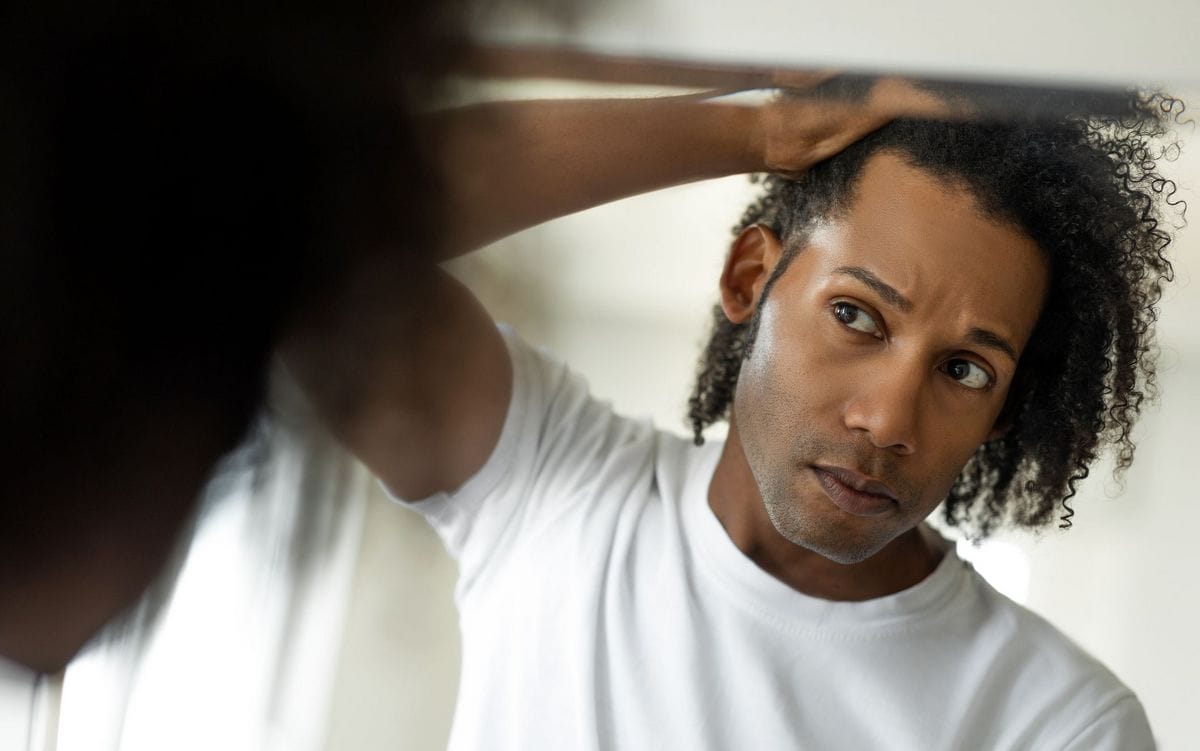Alopecia: Symptom cause and treatment
When we lose our hair, our self-confidence takes a serious hit. Men aren’t the only ones who have to deal with the unpleasant consequences of baldness. The problem also affects a large number of women. The causes of excessive hair loss can be numerous, and the treatment process is not always easy. How to cope with increasing hair loss?

What is alopecia?
Hair loss(alopecia) is the temporary or permanent loss of hair. It affects the entire scalp or a specific area, such as the temples or the crown of the head. The pathological symptom is associated with a loss of hair production in the hair follicle, with excessive hair loss and thinning. It’s important to explain the life cycle of a hair and the periods of its growth.
The hair cycle consists of three consecutive phases:
Anagen is the hair growth phase. This phase is the longest of all, lasting between 2 and 7 years.
On a healthy scalp, around 85% of hair is in this phase.
Catagen is the transition phase in the hair life cycle. It lasts between 1 and 2 weeks. During this period, the diameter of the hair bulb diminishes, and the hair stops growing and prepares to fall out. In the final catagen stage, the hair detaches from the papilla in the hair follicle and approaches the skin surface.
The telogen cycle, affecting around 1% of the total hair population, is a resting phase, i.e. the last stage in the life of the hair, lasting from 2 to 4 months. It is immediately followed by the anagen phase, i.e. the growth of another, new hair from the same bulb.
Around 15% of all hairs are in this state.
On average, 40 to 160 hairs fall out every day. It also depends on many factors, including the season (hair loss is greater in autumn and less in winter). If hair is washed daily, hair loss is regular. If you wash your hair once a week, you may find that more hair falls out.
- Types of alopecia: Depending on cause and pathomechanism, several types of alopecia can be distinguished:

Androgenetic alopecia
It takes two forms: androgenetic alopecia of the female type and androgenetic alopecia of the male type. Female androgenetic alopecia is characterized by diffuse hair loss over the crown of the head, with greater intensity in the frontal region, along the parting.
The hairline on the forehead is well preserved, and hair thinning starts at around 2-3 cm towards the parietal region and top of the head. Female androgenetic alopecia is described according to Ludwig’s formula or Sinclair’s scale.
Male androgenetic alopecia is described according to the Hamilton and Norwood formula, which distinguishes 7 types of hair loss. Male pattern baldness generally begins in the frontotemporal region, then on the parietal region on the top of the head. Hair thinning can also extend to the temples and parietals, leaving a crown of hair on the occiput and partially in the temporal region.
Numerous studies have confirmed the association between androgenetic alopecia and ischemic heart disease. The early onset of androgenetic alopecia before the age of 36 is a major risk factor.

Alopecia areata
Alopecia areata belongs to the group of non-healing forms of alopecia. The disease most often affects young people under the age of 25. The causes of alopecia areata are not fully understood. The most commonly considered is a T-cell-dependent autoimmune background.
Inflammation of the hair follicle plays a major role in the development of the disease. Follicle keratinocytes release pro-inflammatory cytokines that activate endothelial cells. The result is the accumulation of inflammatory cells around the follicle, mainly T lymphocytes and macrophages, which also intensify the inflammatory process initiated earlier. The extent of infiltration determines the damage caused to the hair follicle.
Also read: tips for hair loss after childbirth
In this case, hair loss is a reversible process, since once the inflammation has stopped, the hair follicles resume hair production. The focal areas of alopecia areata are generally regular in shape, devoid of hair, and the skin remains unchanged. The most frequent lesions are located in the occipital and fronto-parietal regions.

Alopecia telogen
Alopecia telogen mainly affects women. Hair loss begins after several months of exposure to the causative agent. Hair is sparse over the entire head, usually no more than 50%. Accompanying symptoms often include scalp pain, burning and itching.
It is important to note that this type of hair loss is not associated with genetic factors. It occurs for physiological reasons, such as hair loss after pregnancy. It can also be caused by emotional stress, anemia, the use of certain medications and infectious diseases such as COVID-19.
- Diagnosis by a dermatologist is extremely important.
Alopecia telogen is entirely reversible, so its diagnosis can reassure patients faced with the problem of excessive hair loss. In general, after 2 to 4 months of excessive hair loss, the hair begins to grow back. Alopecia telogen is diagnosed when at least 25% and no more than 50% of hair follicles are in the telogen phase.

Scarring alopecia
This is the most serious type of alopecia, as it leads to permanent and irreversible hair loss. At the same time, it is a condition that is relatively rarely diagnosed in dermatology clinics in Quebec. The main symptom of cicatricial alopecia is the appearance of characteristic scar-like lesions on the scalp. Most often, they are located in the parietal region.
Also read: how to care for your hair during pregnancy?
Alopecia areata develops slowly, and the scalp in affected areas thins and takes on a shiny texture. Isolated tufts of hair can be observed, forming a so-called brush pattern. Scarring alopecia is also included in atrophic alopecia, in which the damaging factor is an inflammatory reaction.
Depending on its cause, scarring alopecia can be divided into two categories: primary and secondary. In the first form, hair follicles are destroyed by inflammation. In the secondary form, on the other hand, the destruction of hair follicles is a side-effect of a process that generally damages the skin, such as burns, cancer or irradiation.
Factors likely to cause a secondary form of scarring alopecia include complications following a fungal, bacterial or viral infection. Infection occurs locally and leads to inflammation of the skin, involving the hair follicles. Scarring alopecia can also be a symptom of systemic diseases such as cutaneous lupus erythematosus and systemic scleroderma.

Seborrheic alopecia
Seborrheic alopecia is directly linked to seborrheic dermatitis, which is the result of excessive sebum secretion by the sebaceous glands. The sebum layer accumulates on the surface of the scalp, rapidly making hair greasy. It’s also a habitat for bacteria and fungi, which in turn are responsible for the development of inflammation and other skin disorders.
- Also read: PRP and hair regrowth: Is it for you?
Causes of seborrheic alopecia include hormonal imbalance, diseases of the nervous system, immunological disorders and poor diet. The first symptom before the onset of seborrheic alopecia is excessive greasiness of the hair and scalp, and the appearance of dandruff. The hair becomes weakened and thinner. The process of hair loss begins in the temporal arches and progresses towards the crown of the head.

Causes of baldness
Many factors can contribute to excessive hair loss. Hair loss can be the result of past or active illness, chronic stress, iron-deficiency anemia, poor diet, certain medications and inadequate hair care.
Systemic diseases often associated with hair loss include the following:
- Thyroid diseases hyperthyroidism, hypothyroidism, hashimoto
- Infectious diseases
- Diabetes mellitus
- Connective tissue and scalp disorders psoriasis, ringworm, seborrheic dermatitis
- Heavy metal poisoning – the five most dangerous for hair: thallium, lead, bismuth, arsenic, mercury.
- Hormonal disorders: androgenic hormones affect hair follicles, causing androgenetic alopecia, which appears in the corners of the forehead (in men) or on the top of the head (in women).
Among the medications used, hair loss can be influenced by:
- Anticoagulants
- Rheumatological drugs methotrexate, tacrolimus
- Cardiological agents statins, fibrates, angiotensin inhibitors, calcium antagonists
- Antithyroid drugs derived from thiouracil
- Contraceptives according to the predominance of estrogens over gestagens

Diagnosis of alopecia
An important element in the diagnosis of alopecia is a detailed history and thorough evaluation of the scalp. It is then important to find the cause of the problem and implement appropriate treatment.
Diagnosis of alopecia must first be based on tests, among others:
- Morphology
- Thyroid hormone concentrations TSH, FT3, FT4
- Iron concentration
To obtain a complete picture of the condition, it is important to carry out a detailed examination, which consists of:
- Histopathological examination of a scalp section
- Trichoscopy microscopic examination of hair using a video-dermatoscope
- Trichogram, examination of hair on the scalp based on evaluation of its roots under the light microscope.
This sometimes involves plucking a small number of hairs for examination.
In Quebec, the problem of hair loss is treated by a dermatologist

Pharmacological treatment of alopecia
When treating alopecia, in addition to a detailed history and examination, it is important to classify the type of alopecia, find its cause and determine its severity. One of the methods used to combat baldness is pharmacological treatment based on the use of specialized drugs with local and general action in the form of friction.
One of the most effective is minoxidil at concentrations of 2% and 5%. Applied locally to the scalp, it stimulates hair growth by increasing blood flow to the vascular bed. The first effects of application are visible after around 2 months.
Other effective medications used to treat androgenetic alopecia include finasteride at a dose of 1 mg. At higher doses, this substance is used in the treatment of prostate growth. The mechanism of action of this drug is to block the enzyme the enzyme 5-alpha reductase enzyme, thereby reducing the production of DHT in the active form of testosterone, which is the main cause of androgenetic alopecia.
This prevents the miniaturization of existing hair follicles, increases the number of hairs, stops hair loss and has a beneficial effect on hair appearance.
Because of its adverse effect on male genital development in fetuses, and on the urethra and prostate, finasteride is contraindicated in women of childbearing age.
Find a Dermatologist in Quebec:

How can I stop hair loss?
Many people struggling with excessive hair loss wonder how to stop baldness! The answer to this question is not so simple. The main way to treat and prevent hair thinning is to find the cause of the problem, which gives a good percentage chance of cure.
Preventing baldness requires a great deal of sacrifice and regularity in the use of various friction products, shampoos and conditioners, whose main task is to cleanse the scalp, strengthen the hair shaft and prolong its life. Regular self-massage of the scalp is highly beneficial.
Massage improves blood flow to the scalp and, thanks to faster blood circulation, hair follicles receive more nutrients and oxygen. However, for the effects to appear, regularity is required.
Professional treatments to stimulate hair growth and improve hair condition are very popular with dermatologists. One such method is microneedling mesotherapy. The treatment involves injecting a ready-to-use cocktail of active ingredients into the scalp.
- Also read: how to use fenugreek for hair?
Injections stimulate the tissue to regenerate and grow thicker hair. Laser technologies using radio waves are also used. Another option is surgical hair thickening, i.e. transplanting hair into thinning areas. However, this is an invasive procedure that requires waiting several months for the first effects to be felt.
A balanced diet, rich in vitamins, minerals and nutrients, is of great importance in the process of stopping baldness. Products rich in selenium and zinc should be included in the diet, as well as iron in case of deficiency. Selenium is found in nuts, fish and turmeric. Cereals, legumes and dairy products contain large quantities of zinc. Iron is one of the main components of meat, parsley, spinach and beet. We should also remember to keep the body well hydrated. The diet must be based on a sufficient number of calories.
“One of my biggest dreams is that my company will be able to change the course of one family’s life, one child at a time by giving back to the community.”







